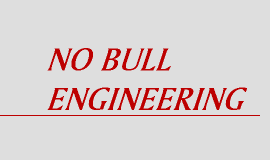PRACTICAL USE OF ROTORDYNAMIC ANALYSIS AND TROUBLESHOOTING SKILLS TO CORRECT A LONG-TERM SYNCHRONOUS VIBRATION PROBLEM
IN AN OVERHUNG TURBOBLOWER
by
Mark A. Corbo, P.E.
President & Chief Engineer
No Bull Engineering
and
Thomas J. Kuli, P.E.
Chief Engineer
Robinson Industries, Inc.
and
H. Leslie (Les) Gutzwiller, P.E.
President
Robinson Industries, Inc.
Originally presented at:
Texas A&M University Turbomachinery Laboratory
31st Turbomachinery Symposium
September 2002
Overhung machines supported on plain cylindrical journal bearings are notorious for suffering from subsynchronous vibration problems due to the lightly-loaded condition that the bearing away from the wheel is normally subjected to. In this case study, two 3000 HP motor-driven overhung turboblowers of titanium construction were observed to suffer from high synchronous vibrations – an entirely different situation from the typical subsynchronous instability. This paper shows how the combination of rotordynamic analysis and troubleshooting skills was employed to identify and generate corrective actions for two independent causes of high synchronous vibrations.
The two subject blowers, units “A” and “B”, are nominally identical and are located adjacent to one another. Operated in parallel, they are used to provide wet chlorine gas to a critical process at a large chemical plant in the southwest. From the date of their commissioning, both units continuously suffered from large synchronous vibrations which led to multiple bearing failures. After several conventional rotordynamic analyses failed to identify the cause of the problem, a less conventional analysis, which utilized a comprehensive model that accounted for both the motor and blower, was successful at identifying the problem as high sensitivity to unbalance loads due to an extremely lightly-loaded (less than one pound) condition at the blower’s inboard bearing. This analysis is not described in detail since much of it has been previously published elsewhere.
Based on the results of the rotordynamic analysis, two changes were made to both units. The couplings were changed from disk to gear couplings and the blower’s bearings were changed from plain cylindrical to tilting-pad designs. After implementing these changes, unit “A” ran smoothly for a period of six weeks, in accordance with the predictions of the rotordynamic analysis, and it appeared to all that the problem was completely solved.
However, when the “B” blower was then started up, all illusions were shattered. The two machines then commenced a three month period of operation in which each suffered from intermittent periods of high synchronous vibrations. During this time, the following behavior traits, which can only be described as bizarre, were observed:
- Whenever a unit was started up, its vibrations would invariably be low. It would take at least a week of continuous running before high vibrations could be observed.
- The transition from low vibrations to high vibrations was almost instantaneous. Additionally, this transition was always accompanied by an axial motion of the blower rotor away from the active thrust bearing.
- The units appeared to be more likely to suffer high vibrations when both were running simultaneously.
- The simple act of starting up one machine could sometimes cause the other machine to transition from low to high vibrations.
- Conversely, shutting down one machine could greatly reduce the vibrations in the other.
- At one point when the vibrations were high, a sudden rainstorm caused them to instantaneously drop.
- Similarly, spraying cold water on the unit sometimes, but not always, was sufficient to eliminate high vibrations.
A task force of experts was then commissioned and an extensive troubleshooting effort was commenced. Some of the potential root causes that were hypothesized included blower surging, starvation of the tilting-pad bearings, thermally-induced misalignment, insufficient blower thrust, buildup of debris on the fan blades, acoustic resonance, locking up of the gear coupling, axial vibration, and seal rubbing. After an extensive troubleshooting effort that included more rotordynamic analysis, bearing flow analysis, blower thrust analysis, and extensive studying of orbit plots, spectrum plots, and vibration and temperature histories, the task force concluded that the most likely cause was rubbing at the blower’s carbon ring seal. Accordingly, the seal was disassembled and its locating pins were found to have come loose and generated a rub. Design changes were then implemented to provide better retention for the pins. The units were then restarted and it was verified that the modifications had finally eliminated the vibration problems.
SYNOPSIS: In this case study, the value of combining rotordynamics analysis with troubleshooting skills is illustrated in the solution of a long-term motor-driven blower vibration problem that exhibited highly erratic behavior. These tools combined to eliminate the many red herrings and pinpoint the source of the problem as a thermally-induced rub at the blower’s carbon ring seal and served to guide the seal redesign to eliminate the problem.
ORDER YOUR FREE COPY
BACK
| Home | Why Hire Us? | Services | Principals & Staff | Clients |
| Technical Papers | Short Courses | News Items | Contact Us |

